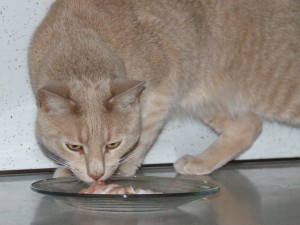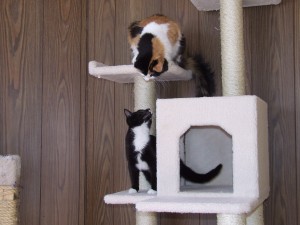Written by Tracy Dion for Raw Instincts Magazine, May 2012, and last updated July 2012.
There are few things more fascinating than watching your cat gracefully explore a meadow or crouch all aquiver in preparation for a pounce. The beauty of the sun shining off her fur and the powerful play of her muscles as she swiftly leaps and pivots to make the catch can be breathtaking.
Unfortunately, outdoor living contains too many dangers for most cat owners to allow their beloved pets the freedom to roam. Pests like fleas and ticks abound (and this upcoming summer looks to be especially bad due to the mild winter most of us enjoyed), and predators like coyotes and hawks can be deadly. In more urban areas, there are dogs, cars and worse.
To protect our cats, we must bring them inside. But doing so incurs responsibilities beyond simply providing food, water and litter boxes.
Cats are born to hunt, to chase, pounce, run, and climb. That need to move doesn’t vanish when they no longer have the space to do so. They are also born for vigilance, the awareness of their status as both predator and prey, and have a need for avenues of escape and places in which to hide.
It is vital for their overall health and happiness that we create an indoor environment that recognizes and addresses these and other innate, natural needs.
Food, Water and Litter Boxes
First and most important, cats should be provided with a raw, animal-based diet. Nutrition is the basic foundation for all aspects of health and cats, as obligate carnivores, are built to utilize the tissue, bones and organs of their prey to grow, repair and maintain every system in their bodies. There are many commercial raw blends available, but home-preparing is less expensive and offers complete control over the mix and quality of ingredients.
For optimal health, feed frankenprey or whole prey diets. The process of scissoring and chomping through flesh, tendons and bones cleans the teeth and promotes dental health by increasing blood flow to the oral cavity. The requirement to “work” to eat also offers psychological benefits by satisfying part of the cat’s predatory nature.

Cats should be fed on shallow bowls or plates that won’t hinder sensitive whiskers, spaced as far apart as possible to reduce tension. Crate-training for meals is advisable, as it will keep the food contained, prevent more aggressive cats from eating their housemates’ portions and allow shyer cats the quiet and security they need to finish their meals completely.
Try to feed at least three meals a day – if you can manage four, so much the better – and serve them in a quiet area that minimizes the chance for disturbances.
Cats don’t like to eat near their water, so fresh water should be provided away from the feeding area. Of course, bowls should be cleaned and refilled daily, and filtered water is generally healthier than tap.
Feral cats instinctively eliminate far from food and water sources to reduce the likelihood of attracting predators, so litter boxes should be placed well away from food and water dishes, and in fairly quiet areas to decrease feelings of vulnerability. Some cats have well-defined preferences in their litter box habits and will not use a dirty box, or will want one box for urinating and one for feces. To accommodate these preferences, provide one box per cat, plus one, and scoop them daily. Very large, uncovered boxes allow cats to dig around, eliminate and bury in a more natural manner.
Play
Without avenues for burning off hunting energy, indoor cats can become frustrated, anxious or even aggressive.
Companions are a good first step. Cats are not the strictly solitary creatures they are so often portrayed to be and owning two or three allows them to engage in social and play activities such as mutual grooming, chasing and wrestling.
Catnip mice, crinkle balls and other small toys can be scattered around the house and hidden inside paper bags and boxes for the cats to ‘hunt’ and bat around. Rotating these toys keeps the interest high.
Daily interactive play sessions using wands, laser lights and other similar toys should be routine. Schedule these games for the same time every day and aim for dusk and dawn when the cats’ natural hunting instincts are in high gear. Drag, dart, and hide the ‘prey’ to fully engage the cats’ hunting behaviors. At the end of each session, toss the cats a treat or a catnip filled toy to provoke in them the satisfaction that accompanies a successful hunt.
Clicker-training cats is a great way to challenge and stimulate their intellect. It can be used to teach them tricks as well as to redirect their attention from unwanted behaviors to more acceptable alternatives.
Exceptionally adventuresome and confident cats can also be taught to walk on a leash or treadmill, participate in cat agility games, or become certified therapy cats.
Environment
While cats are not solitary animals, they are territorial. Providing adequate space, especially vertically, is important. Cats like climbing and lounging on high perches, which allows them to observe their territory from an area of security, but their height preferences are variable. Cat trees and wall shelves with perches at different heights allow for personal preferences, changing moods and multiple “prime” locations; just make sure they’re sturdy enough to take a cat hitting them at a full run.

Cats need scratching posts for claw sharpening, stretching and scent marking; instinctual, daily behaviors that will be exercised upon your furniture if suitable alternatives are not provided. These posts, too, should be sturdy, as well as of sufficient height to allow the cats to reach above their heads. A variety of materials can be used, but sisal rope and cardboard are favored. Cat trees often have sisal-wrapped posts, making them attractive multi-purpose options, and adding a few horizontal cardboard scratching pads will give cats a nice variety of choices.
Cats like to be where their people are, so place the cat trees, shelves and scratching posts in high-traffic areas.
Screened-in porches and outdoor enclosures make great additions to the cats’ environment, allowing them a safe way to enjoy the outdoor experience.
Safety
And speaking of safety, cats need a safe zone, a place to which they can escape and expect to be free from children, dogs, and even other cats if possible. Teach your children that when the cat is occupying this space – a particular shelf or room, for instance – she is not to be disturbed. Ensure that cat trees, wall shelves and litter boxes are set up to allow an exit route should one cat try to trap another.
Routine is also important for cats. Try to schedule activities involving them at the same time every day, and keep to as much of a household routine as you can. Be aware that any change in their environment is going to affect them and try to make unavoidable changes slowly.
Stress can come in less tangible forms as well. Cats have more sensitive hearing than we do, especially at higher ranges. Construction in the neighborhood, yelling and loud music can upset them. Their sense of smell is more sensitive than ours, too, and cleaning solutions, air fresheners, candles, and other commonly-used chemicals can cause distress and anxiety. Don’t let your cats lick you if you have lotion on your skin, and before cranking up the TV for the Sunday game or lighting that cigar, think about the potential impact on your cats and find a way to mitigate it.
Love
Above all, love your cats. Though they have a reputation for independence and an aloof manner, they are actually sensitive, intelligent creatures who will respond to your affections with affection of their own. Spend time observing them; learn their body language, their boundaries and their needs, and respect them.
Taking these steps to recognize and provide for their natural behavior patterns will ensure your indoor cats remain balanced, healthy, and happy, just the way you want them.
If you enjoyed this article or found it informative, please “Like” it, “Tweet” it, or share it using any of the buttons below. And don’t forget to check out our FB page, join the discussions in our awesome FB group and follow us on Twitter!
Created 03/26/12; Updated 08/11/14




